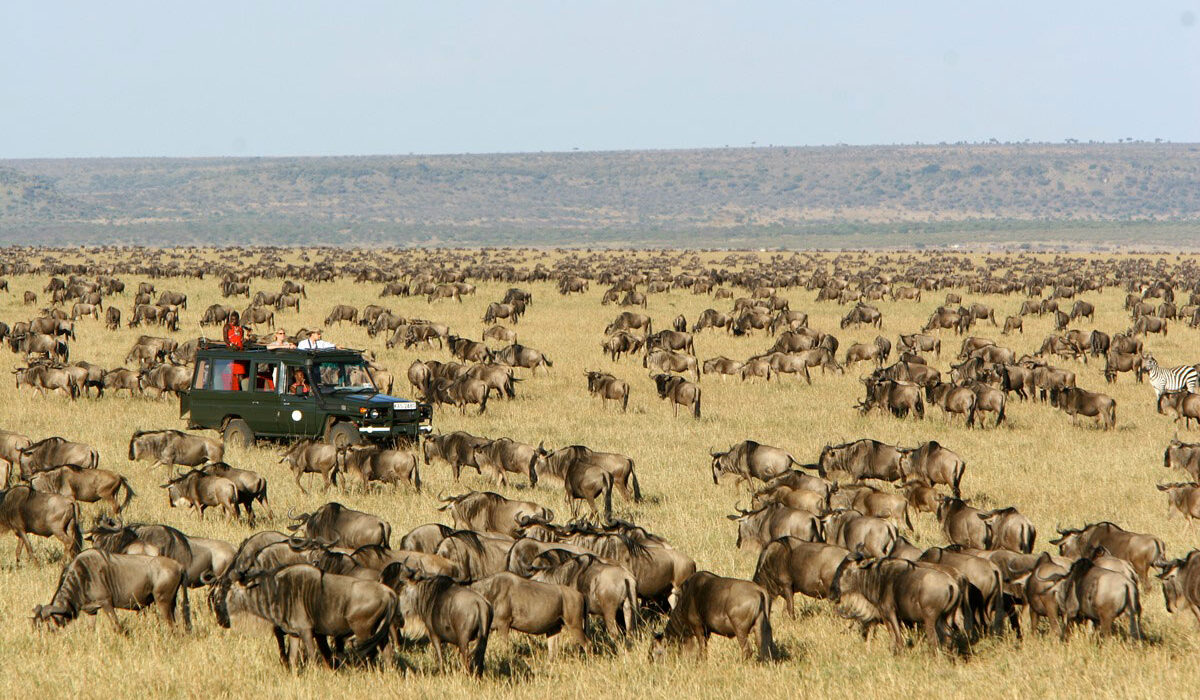The Masai Mara National Reserve is arguably Kenya’s most iconic wildlife destination, famed globally for its annual Great Wildebeest Migration and as home to the Big Five. Situated in the southwestern part of Kenya along the Great Rift Valley, the reserve covers approximately 1,510 square kilometers and is a must-visit for both locals and international tourists.
Unlike most other parks in Kenya, which are managed by the Kenya Wildlife Service (KWS), the Masai Mara is managed by the Narok County government. This unique management structure ensures that park entry fees and regulations are tailored to optimize the visitor experience while conserving the delicate ecosystem.
In this comprehensive guide, we’ll provide detailed insights into the current entry fees for the Masai Mara National Reserve in 2024, highlight key attractions, and discuss tips for making the most out of your visit.
Why Visit Masai Mara?
The Masai Mara offers a once-in-a-lifetime opportunity to witness the Great Wildebeest Migration, an awe-inspiring natural spectacle where over two million wildebeests, zebras, and gazelles migrate from the Serengeti in Tanzania into the Mara in search of fresh grazing grounds. This migration occurs from July to October, drawing tourists, photographers, and filmmakers from around the world.
In addition to the migration, the reserve is home to the Big Five—lions, leopards, elephants, buffaloes, and rhinoceroses. Visitors also have the opportunity to see cheetahs, hyenas, crocodiles, hippos, and a variety of antelopes, all set against the backdrop of the sweeping savannahs and acacia trees.
Masai Mara National Reserve 2024 Entrance Fees
The entrance fees for Masai Mara National Reserve vary depending on visitor status—whether you are a citizen, an East African resident, or a non-resident. Here’s a detailed breakdown of the entry fees in 2024:
a) Citizens (Kenyan Citizens)
- Adult: Ksh 3,000
- Child/Student: Ksh 1,000
b) East African Residents
Residents of Kenya, Uganda, Tanzania, Rwanda, and Burundi enjoy discounted entry fees due to the East African Community arrangement. To qualify for this rate, visitors must present valid identification or work permits.
- Adult: Ksh 4,500
- Child/Student: Ksh 2,000
c) Non-Residents
The entrance fees for non-residents are split between two seasons:
- January – June:
- Adult: USD 100 per day
- Child/Student (9-17 years): USD 50 per day (children below 8 years enter free)
- July – December (peak season):
- Adult: USD 200 per day
- Child/Student (9-17 years): USD 50 per day
Vehicle Entry Fees
If you plan to visit the Masai Mara in a private vehicle, the following vehicle entry fees apply based on the vehicle’s seating capacity:
- 5 seats or less: Ksh 500
- 6 seats but less than 12: Ksh 1,000
- 13 seats but less than 24: Ksh 3,000
- 25 seats but less than 44: Ksh 4,000
- 45 seats and above: Ksh 5,000
Key Points to Remember
- Children Rates: The children’s rates apply to individuals above three years but below 18 years.
- Students: To qualify for student rates, a valid student ID must be presented.
- Identification: Ensure you carry your national ID, passport, or work permit, especially if you are claiming resident or citizen rates. Without these, you may be charged at the higher non-resident rates.
What’s Special About Masai Mara National Reserve?
The Masai Mara is a cornerstone of Kenya’s tourism industry, and it stands out not only for its abundant wildlife but also for its rich cultural experiences and historical significance. Here’s why the reserve is a must-visit:
1. The Great Wildebeest Migration
Every year, between July and October, the Masai Mara witnesses one of the greatest wildlife spectacles on Earth—the Great Wildebeest Migration. This mass movement involves over two million wildebeests, zebras, and Thomson’s gazelles migrating from the Serengeti in Tanzania into the Masai Mara in search of greener pastures. The migration is not only about movement but also about survival, with predators such as lions, cheetahs, and crocodiles lying in wait to prey on the weak and vulnerable.
2. The Big Five
The Masai Mara is home to all of Africa’s Big Five—lions, leopards, elephants, buffaloes, and rhinoceroses. These majestic animals draw visitors from all corners of the world, making it one of the best destinations for wildlife photography and game drives. If you’re fortunate, you may witness a pride of lions on the hunt or a herd of elephants with their calves grazing peacefully.
3. Cultural Encounters with the Maasai People
A visit to the Masai Mara is incomplete without engaging with the local Maasai people. Renowned for their distinctive culture and traditional way of life, the Maasai offer visitors a glimpse into their community through village visits, where guests can learn about their customs, participate in traditional dances, and purchase beautiful beadwork and handicrafts.
Accommodation Options in the Masai Mara
The Masai Mara offers a wide range of accommodation options, catering to different budgets and preferences. Whether you are looking for luxurious lodges, comfortable tented camps, or budget-friendly campsites, the reserve has something for everyone. Here are some of the most popular accommodation choices:
1. Luxury Lodges
For those seeking an opulent experience, the luxury lodges within and around the reserve provide world-class amenities, gourmet dining, and private game drives. Some renowned luxury lodges include:
- Mara Serena Safari Lodge: Overlooking the Mara River, this lodge offers panoramic views of the plains and is an ideal spot to witness the migration crossings.
- Angama Mara: A high-end lodge perched on the edge of the Oloololo Escarpment, offering stunning views and exclusive experiences.
2. Tented Camps
For a more immersive experience, staying at a tented camp is an excellent choice. Tented camps range from mid-range to luxury and allow visitors to experience the wilderness up close. Some popular options include:
- Kichwa Tembo Tented Camp: Known for its exceptional service and location in the northern part of the reserve.
- Governors’ Camp: One of the oldest and most renowned camps in the Mara, with a prime location along the Mara River.
3. Budget Campsites
For budget travelers or those seeking a more adventurous experience, there are several public campsites within the reserve. These campsites offer basic amenities and provide a great way to experience the Mara on a budget.
Best Time to Visit Masai Mara National Reserve
The Masai Mara is a year-round destination, but the best time to visit depends on what you want to experience:
- July to October (Great Migration): This is the peak season for witnessing the Great Migration. The dramatic river crossings, where wildebeests and zebras brave the crocodile-infested waters of the Mara River, are the highlight of this season.
- December to February: During this time, the weather is warm and dry, making it ideal for game drives and spotting predators. This is also a great time to see young animals born after the rains.
- March to June: This period marks the rainy season, with fewer tourists in the reserve. The landscape is lush and green, and while some roads may be challenging to navigate, it’s an excellent time for birdwatching.
Tips for Visiting Masai Mara National Reserve
- Book in Advance: The Masai Mara is a popular destination, especially during the peak migration season. It’s advisable to book your accommodation and park entry in advance to avoid disappointment.
- Choose a Reputable Tour Operator: Working with a reputable tour operator ensures that you have knowledgeable guides and reliable transport. They can also help you maximize your wildlife sightings and cultural experiences.
- Pack the Essentials: Depending on the time of your visit, the weather can be unpredictable. Pack essentials such as comfortable clothing, a hat, sunscreen, insect repellent, binoculars, and a good camera.
- Respect the Wildlife and Local Culture: While on a safari, always follow your guide’s instructions, maintain a safe distance from the animals, and avoid loud noises. When visiting Maasai villages, be respectful of their traditions and seek permission before taking photographs.
The Masai Mara National Reserve is a gem in Kenya’s tourism crown, offering unforgettable wildlife experiences, captivating landscapes, and rich cultural encounters. With entry fees structured to accommodate citizens, East African residents, and non-residents, the reserve remains accessible to a diverse range of visitors.
Whether you are planning to witness the Great Migration, encounter the Big Five, or immerse yourself in Maasai culture, the Masai Mara has something for everyone. By understanding the 2024 entry fees, planning your trip accordingly, and following our tips, you’ll be well-prepared for an incredible adventure in one of Africa’s most celebrated game reserves.
When visiting, remember to contribute to the conservation efforts by respecting the rules, supporting community-based tourism initiatives, and minimizing your environmental impact. In doing so, you’ll play a part in preserving the beauty and biodiversity of the Masai Mara for future generations.





